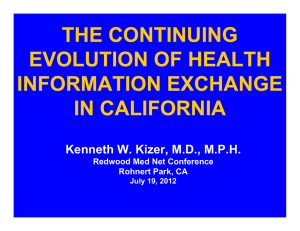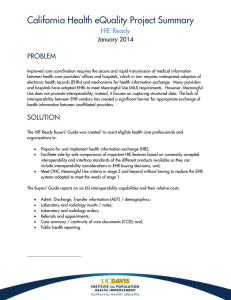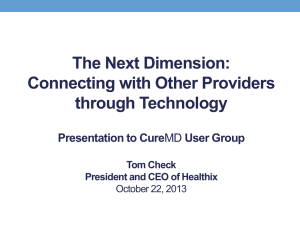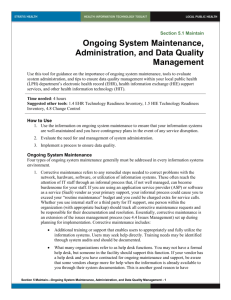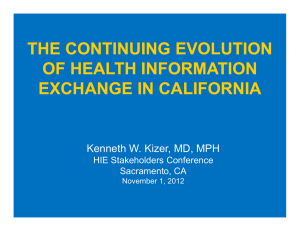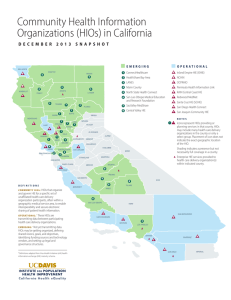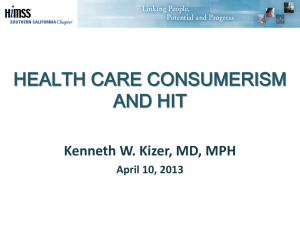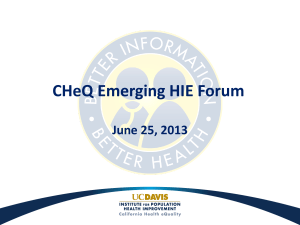HIE Strategy in California and Stage 2 Meaningful Use
advertisement
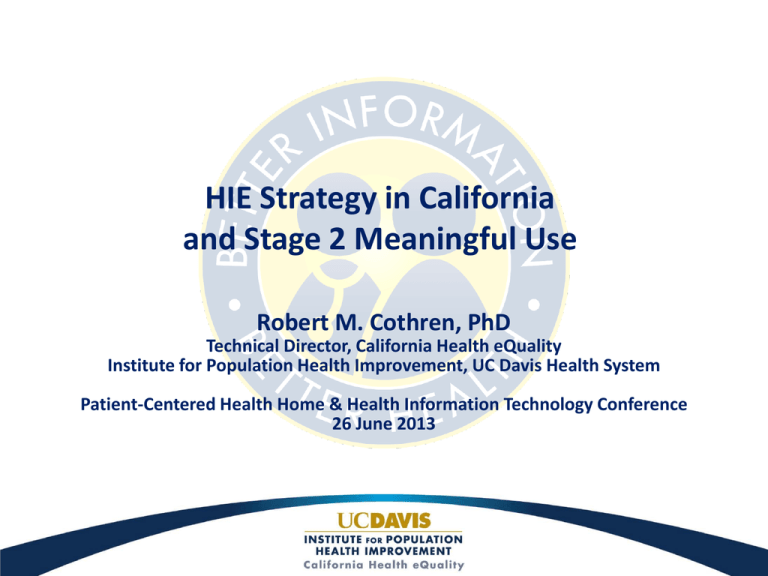
HIE Strategy in California and Stage 2 Meaningful Use Robert M. Cothren, PhD Technical Director, California Health eQuality Institute for Population Health Improvement, UC Davis Health System Patient-Centered Health Home & Health Information Technology Conference 26 June 2013 Agenda Context California’s Strategy for HIE Impact on Meaningful Use What this all means to you… 2 In the beginning… 2004 Presidential order: … an electronic health record for every American that wants one by 2014. Created the Office of the National Coordinator for Health Information Technology. Started the Nationwide Health Information Network. 3 …and then along came HITECH American Recovery and Reinvestment Act of 2009… Establishes ONC permanently. Creates incentive program (~$18B) for adoption and meaningful use of EHR technology for eligible providers and hospitals. Creates statewide HIE initiatives (~$500M). Other stuff (RECs, workforce, Beacons). 4 Meaningful Use Meaningful Use and EHR certification are driving the industry today. Driving common functionality in EHR systems. Increasing adoption through incentives. Creating the electronic information for HIE to exchange. 5 Meaningful Use Stage 1 capture structured information in EHRs Stage 2 exchange structured information among providers and patients Stage 3 improve outcomes through analytics 6 Instruction from ONC “PIN” Priorities e-Prescribing Electronic lab results delivery Care summary exchange …and for Public health reporting… Immunizations As appropriate on a Reportable conditions per-state basis… Syndromic surveillance 7 So what about California? 8 California’s strategy… Promote community / enterprise activities. Promote exchange among communities / enterprises. Make centralized infrastructure as lightweight as possible. Support access to government systems. Support access to national networks. 9 Longitudinal Record Directed Emerging models for HIE Direct (secure email) Results Delivery (HL7 messages) Provider Lab Radiology Centralized (community record) Provider Lab Radiology Federated (virtual record) Provider Lab Radiology Hub(s) Provider For the provider that has nothing… Hub Provider For the provider with an EHR… ? Data Data Data Provider For providers in a community… RLS ? Provider For providers that want to “own” the infrastructure… 10 Emerging shift in service delivery From… HIOs which provide governance for exchange activities and technology to accomplish exchange. …to a mix of… HIOs that may or may not provide technology, and HIE Service Providers that provide the technology alone. 11 The real requirements for Meaningful Use 1. Computerized provider order entry 2. e-Prescribing 3. Record demographics 4. Record vitals 5. Record smoking status 6. Use clinical decision support 7. Patients view, download, transmit 8. Clinical summaries to patients 9. Protect electronic health information 10. Incorporate lab results 11. Generate patient lists 12. Reminders for follow-up care 13. Patient educational resources 14. Medication reconciliation 15. Transmit care summaries for transitions of care 16. Report immunizations 17. Secure messaging with patients …plus menu items… 18. Report syndromic data 19. Record electronic notes 20. Imaging results 21. Record family history 22. Report cancer cases 23. Report other registry cases 12 The real HIE requirements for Meaningful Use 1. Computerized provider order entry 2. e-Prescribing 3. Record demographics 4. Record vitals 5. Record smoking status 6. Use clinical decision support 7. Patients view, download, transmit 8. Clinical summaries to patients 9. Protect electronic health information 10. Incorporate lab results 11. Generate patient lists 12. Reminders for follow-up care 13. Patient educational resources 14. Medication reconciliation 15. Transmit care summaries for transitions of care 16. Report immunizations 17. Secure messaging with patients …plus menu items… 18. Report syndromic data 19. Record electronic notes 20. Imaging results 21. Record family history 22. Report cancer cases 23. Report other registry cases 13 The Meaningful Use cases for HIE Electronic ordering and results delivery Care coordination and transitions of care Public health and other reporting Electronic information for patients 14 Our Programs 15 Expansion and Acceleration Creating HIE options for providers. Planning for new HIOs Expansion of existing HIE infrastructure New interfaces to labs, radiology, etc. Conversion of lab data to LOINC terminology New interfaces for public health reporting New services for rural providers 16 Trust Framework Breaking down the walls between systems. Reducing the cost to join. Supporting development of model agreements Creating communities of trust Creating provider directories 17 Expanding Public Health Capacity Reading public health for Meaningful Use. Making public health data accessible. Improving population health. Creating gateways to register, validate, and submit public health data Creating a home for data on high-impact conditions, special populations 18 So what does this mean for you? 19 1. Veterans Affairs There are options 20 2. HIE Ready There are EHRs that are better prepared for HIE. It is easier to determine which EHRs support HIE. It is easier to order interoperability. See http://www.ucdmc.ucdavis.edu/iphi/Programs/cheq/HIEready.html for more information. 21 3. Immunization Gateway Service The California Immunization Registry is ready to receive your data. You can now register and send data compliant with MU. See http://cairweb.org/imp/ for more information. 22 Longitudinal Record Directed 4. Direct (secure email) Results Delivery (HL7 messages) Rural Incentive Program Provider Lab Radiology Centralized (community record) Provider Lab Radiology Federated (virtual record) Provider Lab Radiology Hub(s) Provider For the provider that has nothing… Hub Provider For the provider with an EHR… ? Data Data Data Provider For providers in a community… RLS ? Provider For providers that want to “own” the infrastructure… There are now options for providers in rural California. Identified 5 service providers with varying offerings. Subsidizing 65% of the cost of getting connected. See http://www.ucdmc.ucdavis.edu/iphi/Programs/cheq/cheqrural.html for more information. 23 Questions 24 Contact Information Robert M. Cothren, PhD Technical Director, California Health eQuality Institute for Population Health Improvement UC Davis Health System p 916-731-1375 e robert.cothren@ucdmc.ucdavis.edu w http://www.ucdmc.ucdavis.edu/iphi/Programs/cheq/ 25
